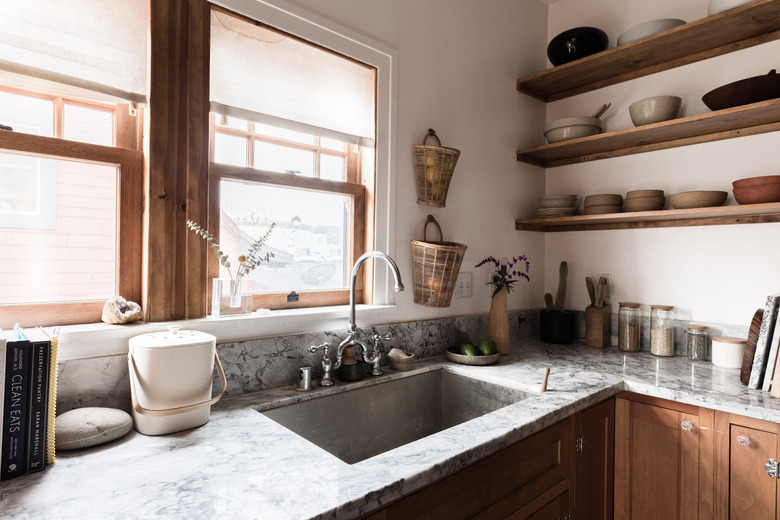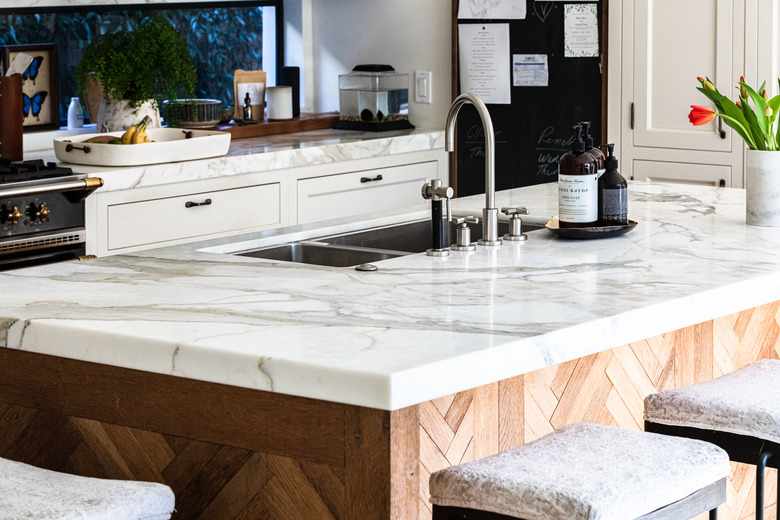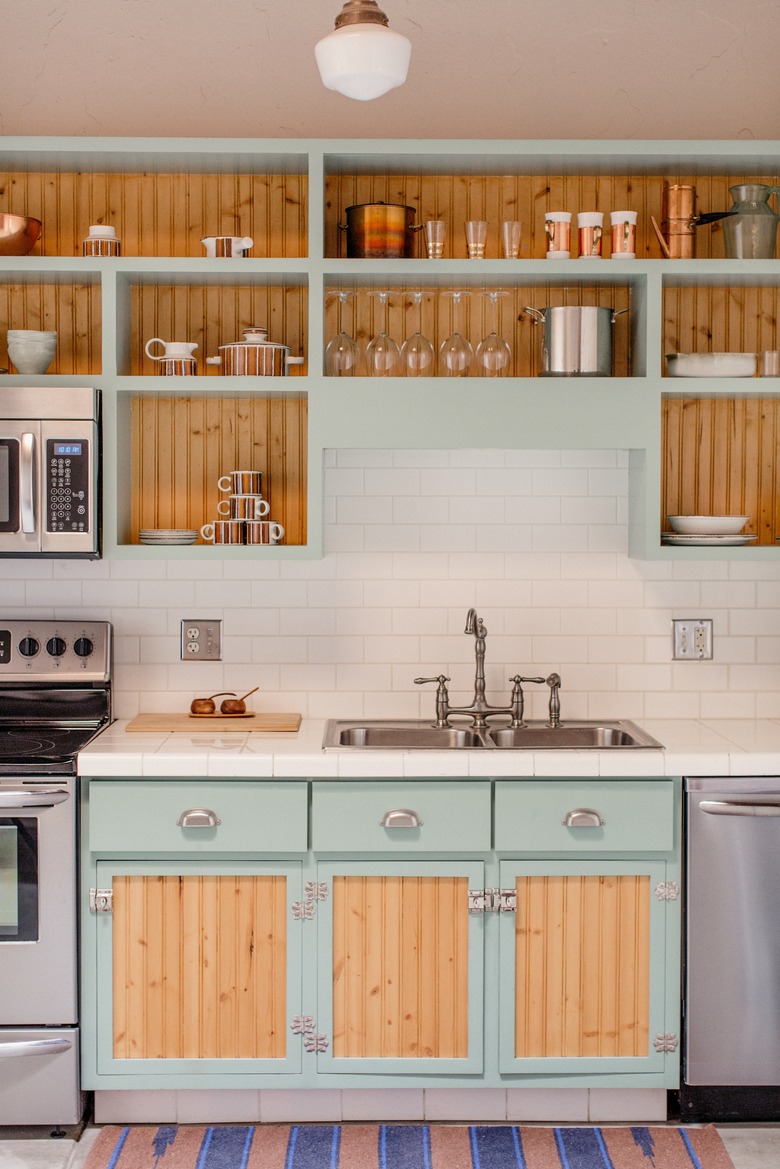Double-Handle Kitchen Faucets: What You Should Know
- Reasons to choose a double-handle kitchen faucet
- Your sink or countertop needs three holes
- Double-handle faucet buying guide
- How to install a double-handle kitchen faucet
- How to identify a compression-style faucet
- Common problems with double-handle faucets
- Repairing a leaky double-handle faucet
- Can I use my old bathroom faucet in the kitchen?
A double-handle kitchen faucet offers a more traditional look for your kitchen than a single-handle one, and there's a good reason. In the not-so-distant past, the double-handle faucet was the only type you could buy. Single-handle faucets didn't come on the scene until Al Moen invented and manufactured the first one in the 1930s, as documented by Reference for Business.
Moen's invention and the single-handle faucets that came after it, such as those made by Delta, American Standard and other manufacturers, are known as washerless faucets. This is a reference to the compression valves in all the double-handle faucets of the time that relied on washers to stop water flow. Compression-style double-handle faucets are still common, but they are gradually being replaced by faucets with cartridge valves, which are the types of valves Moen invented and for which the company named after him is best known.
What does this bit of history means for a shopper looking for a two-handle kitchen faucet? The ones with compression valves are the originals. They are often more traditional in appearance and are the most likely to fit with an early American or utilitarian design scheme. A more contemporary-looking and stylish double-handle kitchen faucet that fits into a modern design scheme is probably going to have cartridge valves.
Reasons to Choose a Double-Handle Kitchen Faucet
The main draw of a double-handle kitchen faucet is that it offers more control over temperature and flow rate than a single-handle one. Because the hot and cold lever handles are separate, you can incrementally adjust the temperature by hand rather than relying on an internal valve that may be old, worn and partially blocked by scale. Some people think two handles is a disadvantage in a busy kitchen, but as Kitchn points out, if you have one hand free to adjust one handle, it's not a big deal to adjust the other one too.
Another good reason to choose two handles is that the faucet can stay in operation if one of the valves leaks. Repair is easier than for a washerless faucet because you only have to turn off one shutoff valve to replace the worn part, which is usually an inexpensive washer, although the repair can entail replacing an O-ring or a slightly more expensive cartridge if you have that type of faucet. Either way, you can still use the faucet until you get around to making the repair.
Double-handle faucets come in formats that only work with two-lever handles, such as the bridge faucet, which works best as a bar faucet but can also be used in the kitchen. Wall-mount and widespread faucets also require two handles. You may be constrained to purchase one of these because of the existence of predrilled holes in the sink or countertop or the type of kitchen sink you have, but it's also possible that you just like the way they look.
Your Sink or Countertop Needs Three Holes
Before you begin searching for the perfect two-handle faucet, you should make sure your sink can accommodate one. The sink needs at least three faucet holes, and the spacing between the two outside holes for a kitchen faucet is always 8 inches. A double-handle faucet with a detached side sprayer requires four holes. If your sink only has a single hole, that limits your choices to single-handle faucet models because drilling new faucet holes in a sink deck is difficult to do accurately and is something you probably shouldn't try.
The fact that your sink only has three holes doesn't mean you can't have a sprayer. Two-handle faucets can come equipped with pull-down and pull-out sprayers, just like single-handle ones. Faucets with pull-down sprayers are angled downward toward the sink, while those with pull-out sprayers are angled toward the user, who then can use the sprayer to fill pots on the countertop or stove. If you want one of these and your sink has four holes, you can always use the extra hole for a soap dispenser.
Double-Handle Faucet Buying Guide
A double-handle kitchen faucet may be among the cheapest kitchen faucets you can find, or it may be one of the priciest depending on the style and the material from which it's made.
A basic plastic or polished chrome model can be had for less than $50 at any home-supply outlet. Delta, Moen and Pfister models tend to be the least expensive, and Home Depot's proprietary brand, Glacier Bay, makes the least-expensive models of all. A specialty brushed nickel or stainless steel faucet for your farmhouse kitchen from any of these manufacturers and others, such as Kingston Brass, can set you back almost $500, however.
You can choose the spout configuration to make the most of your sink. The four major configurations are:
- Standard swivel: The spout on the least-expensive faucets extends straight and is long enough to reach the center of a standard sink. Most standard double-handle kitchen faucets have a swivel spout, which you need if you have a double-bowl sink. Most wall-mount faucets have two handles and a standard swivel spout.
- Gooseneck: The arm of a gooseneck faucet forms a high arch, which allows you to fit large pots under the spout. This type of spout can also swivel, making the faucet almost as useful as a pull-down or pull-out one.
- Pot filler: A must in a commercial kitchen, a pot filler is a wall-mount faucet with a faucet arm that unfolds to reach pots on the countertop or stove. This type of faucet can actually have three handles: two located on the faucet body and one located next to the spout so you can more easily turn the water on and off when you're filling pots.
- Bridge: The most ornate of two-handle kitchen faucets, the bridge faucet features a chrome, brushed brass or stainless steel finish and decorative curves. Water flows from the handles to the spout through exposed pipes that rise about 4 to 12 inches above the sink deck, and the spout, which usually swivels, is also placed at this height, affording extra room for washing pots.
The opposite of a bridge faucet, the widespread faucet, features handles that are apparently disconnected from the spout because the connection hoses are under the counter. This type of faucet works best when the faucet holes are drilled in the countertop, and it's a great accessory for an undermount sink.
How to Install a Double-Handle Kitchen Faucet
Many faucet reviewers consider double-handle faucets to be more difficult to install than single-handle models, but the difference isn't really that great and shouldn't discourage any DIYer. To install a standard deck-mount model, you simply pass the threaded rods through the sink holes, tighten the retaining nuts from underneath the sink using pliers or a basin wrench and then screw on the flexible water hoses and connect these to the water-supply valves.
Widespread faucets and those with side sprayers are a little trickier to install. Besides affixing the spout and handles separately to the countertop, you have to connect the supply hoses. Most manufacturers make the job easy by furnishing quick-connect fittings on the supply hoses of quality faucets, but when you install a budget model, you might have to screw the fittings together with a wrench.
How to Identify a Compression-Style Faucet
If you have to repair your double-handle kitchen faucet, it's good to know what type of valve the faucet has before you take it apart so you know what kind of problems to expect. It's actually pretty easy to distinguish a compression-valve faucet from one that has cartridge valves:
- Compression valves have screw threads, and you have to turn the handle through several rotations to completely open or close one. The handle on a faucet with a cartridge valve, on the other hand, turns only 90 degrees.
- The style of the handles is often a giveaway. Clear plastic and cross handles are typical of traditional compression-valve faucets, whereas the handles on cartridge-valve faucets are often streamlined and fashioned into geometric shapes.
Common Problems With Double-Handle Faucets
The two problems you're most likely to encounter are poor or erratic water flow and leaking. You seldom need a plumber to fix these problems — just a screwdriver, locking pliers and a rag to protect the faucet finish from the pliers.
When any type of faucet delivers lower water flow than you expect, the first thing to do is to take off the aerator and clean it. If that doesn't help, you usually have to clean the valve on the hot side, the cold side or both. You do that by unscrewing the handle and the valve retaining nut, removing the valve or cartridge and dissolving the scale by immersing the valve overnight in vinegar. Don't forget to turn off the shut-off valve before you disassemble either handle.
Repairing a Leaky Double-Handle Faucet
When a double-handle faucet leaks, the temperature of the dripping water usually indicates which valve is responsible. If the faucet has compression valves, turn off the hot or cold water as necessary, disassemble the faucet handle, remove the valve and remove and replace the washer on the end of the compression stem. That's all you have to do, and it shouldn't take longer than about 10 minutes, not including the time you need to go to the store for a new washer.
If your faucet has cartridge valves, the best way to handle a leak is to replace the cartridge. You can buy cartridges for most faucet models at any well-equipped hardware or home-supply store, and they typically cost from $10 to $15. When you buy the new cartridge, it's important to remember whether it's for the hot or the cold water because the cartridges for the two valves have different orientations. To install it, turn off the water, disassemble the handle, remove the old cartridge, drop in the new one and reassemble the faucet. Easy peasy.
Can I Use My Old Bathroom Faucet in the Kitchen?
Two problems prevent you from recycling your old double-handle bathroom faucet as a kitchen faucet. The first is that the spread between the faucet holes for a bathroom faucet is 4 inches, not 8. The second is that the spout reach is too short for a kitchen sink. Your old bathroom faucet may find new life on a fiberglass utility sink, through which it is possible to drill new faucet holes but not in the kitchen.
References
- Reference for Business: Moen Incorporated – Company Profile, Information, Business Description, History, Background Information on Moen Incorporated
- Home Addition Plus: Single Handle Faucets Versus Dual Handle Faucets
- The Pink Plumber: Faucet Plumbing: One Handle vs. Two Handles
- Consumer Reports: Faucet Buying Guide


